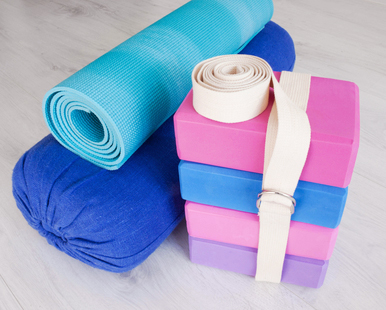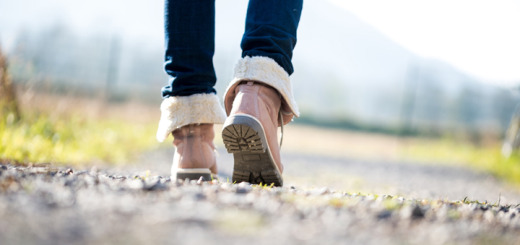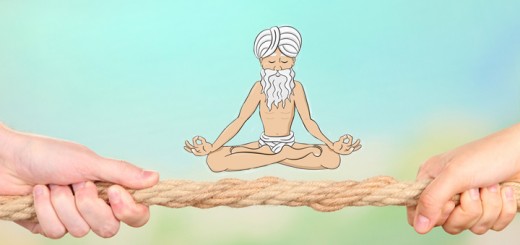Going Propless
13I realize this may cause a scandal, but it’s time to come clean.
For the past 10 years I have practiced yoga propless.
When it started, I was dealing with chronic anxiety and I felt like yoga might help. I didn’t go out much in those days and wanted to avoid a group class. So I headed to the bookstore, grabbed a few books, and learned how to practice in the safety and comfort of my own home.
I picked up two books that day. Each had totally different takes on the necessity of props.
The first book began by compiling a list of all the props I would need in order to start my yoga practice: a mat, blocks, blankets, straps, wedges, bolsters and, meditation cushion.
The second book made no mention of props. It simply told me how to practice.
So I began to practice. No props, no fuss- just me, my body, and my breath.
It wasn’t until years later, when I took a class at a local studio, that I realized how prevalent props where in modern yoga practice. I got to class early and parked myself in the perfect spot. Other than my mat, I was completely propless.
One of the other students came in and told me I would need some props. She rambled off a list; 3 blocks, 5 blankets, 2 straps, 2 bolsters, and 2 – 5lb sand bags to be exact. Seriously? By the time I gathered all that stuff and got settled back on my mat I was ready for Savasana!
As the class proceeded, every pose required a prop (or three). The time between poses was filled with changing out and adjusting the props. I found it very distracting and I didn’t feel the same soul nourishing benefits I got when I did my prop-free practice at home.
Yoga is somewhere the neighborhood of four thousand years old and in the span of that time props have occupied very little of its history. It’s only in our modern culture that props have gained so much fame. You can purchase them almost anywhere- the grocery store, the book shop, the street corner. It seems there are endless opportunities to buy more stuff in order to do something that requires nothing but your body and your breath.
I want to be clear. I’m not knocking props. They can play a vital role in a yoga practice. They provide relief from pain and discomfort; help bring awareness to specific areas of focus, and offer support or adjustment in positioning. These are all important and even necessary uses for props. Unfortunately, it’s not the only way props are used.
Many times a teacher will use a prop as a way to ‘help’ a student get themselves into the correct shape of a pose. This can create the impression that the goal of yoga is to achieve the shape and that by achieving the shape you will reap more benefit. There are two problems with this approach.
First, the benefit of a pose comes from the effect it creates in the body not necessarily the pose itself. There are multiple ways to create that effect independent of the pose. Ponder; is your goal just to do the pose, or are you trying to create an effect?
Second, not all poses are meant for all bodies, and props or no props, when the primary goal is to achieve a shape it raises the risk of injury.
As I look back on my experience with that prop heavy yoga class, what I remember most was how un-safe it felt. There was a strategic method to the prop placement which automatically put my body in the position the teacher deemed as correct. There was no choice as to how deep I would go into the pose because as I followed the instructions, I was just put there. I found myself in positions that were much deeper than were appropriate for me and I felt danger in parts of my body where I had never felt danger before.
At the time I was no stranger to yoga. I had been training with a master teacher for over 2 years and as a teacher myself; I was paying attention to what was happening in the room. Amid the ooh’s and ah’s of those who were clearly enjoying the bliss of the class, I heard sighs of frustration and huffs of discomfort. I saw grimaced faces and confused looks. And as I weighed that with what I was experiencing in my own body I pondered the freedoms of a propless practice.
Freedom:
– to explore an appropriate and comfortable range of motion.
– to choose how deep to go into any given pose.
– to focus on the uninterrupted flow of the practice- no grabbing for props between poses.
– to direct the attention inward- away from the outward distractions that props might provide.
A propless practice can remove the perception that there is a perfect form or right way to do a posture. It can create space to grow, explore, and discover your own limitations and abilities as well as provide room to play with different adaptations and variations of poses. Most of all going propless gives you the freedom to come to your mat and practice yoga anytime, anywhere, without a ding dang thing… even a mat.
 Trish Elting is an AVI Certified Viniyoga Therapist and Teacher + RYT-500. When she’s not teaching private yoga lessons, helping students create beautiful at-home practices, or blogging her lil’ heart out, she’s the front chick for a yoga- and chant-inspired cello band. Trish hosts nurturing retreats and online classes for yoga teachers and yoga lovin’ non teachers. One of her passions is helping teachers explore creative ways to manage and grow their business. Hang out with Trish over on facebook, or twitter. www.trishelting.com.
Trish Elting is an AVI Certified Viniyoga Therapist and Teacher + RYT-500. When she’s not teaching private yoga lessons, helping students create beautiful at-home practices, or blogging her lil’ heart out, she’s the front chick for a yoga- and chant-inspired cello band. Trish hosts nurturing retreats and online classes for yoga teachers and yoga lovin’ non teachers. One of her passions is helping teachers explore creative ways to manage and grow their business. Hang out with Trish over on facebook, or twitter. www.trishelting.com.





















Your post has opened up a new way of thinking for me! Thank you.
You’re welcome Alison! Have fun exploring how you use or don’t use props. 🙂
I agree with you
I agree with you entirely. In all my 25 years of yoga practice I have never used “props”. I feel that if the pose cannot be done without props then you should either not do that pose or use an easier form of it.
Debbie- Nice to have another girl in the propless club.
Margaret- Thanks for sharing that. I use the same principal when practicing myself and working with my students.
Hi…Many thanks for your great comments and thoughtful sharing. For my personal practice, after many years, I’ve gone almost completely propless…mostly because they have become unnecessary. As a teacher who typically leads senior, gentle, and beginning yoga, I’ve found that appropriate props are invaluable. It helps older, more inflexible bodies to find greater comfort, safety, and confidence in more challenging poses (e.g., forward bends when the floor is far, far away, a chair for a 90-year old student, blankets to pad ankles and knees for a student with severe arthritis). As time goes on, I watch the awesome adaptability of these students’ bodies and the props remain in the closet. Love reading your posts…
Janis- Thanks for sharing your experience with using props with your students. It is true that in many instances props are super helpful and even necessary (some of my favorite props to use with clients are chairs and walls). Isn’t it amazing to watch what happens when you meet your students where they are, then let them explore what happens as they practice over time. As teachers we are blessed to be able to witness these kinds of transformations.
I started serious Yoga study at age 64. I welcome being able to use props. Four years later I still use them. They are not for permanent use. For instance, I use a block on each side of Utthita Trikonasana to help stretch my tighter left side and my more bendy right side. I use the blocks at different heights for each side. I put my finger tips on the blocks and slowly, over time, work to get my palm flat on the block. This gives me a small “edge” to work on and toward, and improve without injury. I recommend older beginners accept and learn how to use props. I’m an Iyengar junkie. YMMV
Hi, Ed…How delightful to hear your beginning at 64. While I taught yoga in my 20’s and 30’s, I left hatha for horses at 40. I returned to serious yoga at 64 also! Now, at 68, I teach seniors, gentle, chair, and beginning/intermediate classes. Without props, I could not have advanced without a great deal of pain and discouragement…now I rarely need them. I watch this same transformation process with many of my older and physically challenged students. What joy!
Props help going deeper into the posture, but are they a must??? It’s up to the individual to decide. Teachers should show options of how to use them, but not mandate them.
Ed- How wonderful that you began studying yoga at 64, I think that’s awesome! I love that you shared your progression with the use of props, and how it changes and varies as your practice grows. I also appreciated that you have a clear purpose and intention with why and how you use them. Thanks so much for sharing your experience. Keep up the good work!
And yes, I agree that props can be a wonderful support to older beginners (and not-so-older beginners too). It’s all a matter of what works for each person and what they feel most comfortable with.
Ghada- Exactly, props are a very personal choice. Students should be encouraged to use or not use props based on their own preferences.
I think that in addition to showing options on how to use props, there is a skill that teachers can develop in teaching students how to adapt poses without the use of props. Both approaches are useful and appropriate depending on the student, the desired effect the teacher is using the pose for, and the location that you are teaching from.
I have talked with teachers who have classes in locations where props are not available. The ability to teach students a propless approach is especially useful in these kinds of situations.